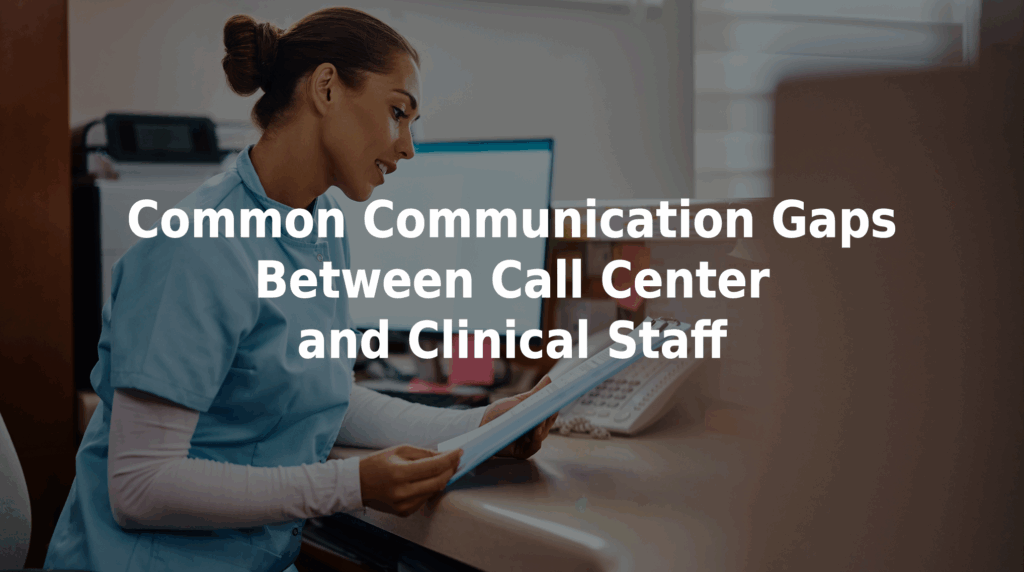Common Communication Gaps Between Call Center and Clinical Staff
One of the most persistent challenges in healthcare operations is miscommunication between staff in call centers and on clinical teams. Nurse managers often find themselves balancing administrative workflows and clinical care delivery, especially with information that nonclinical operators collect and pass along for nurses to use. Let’s explore the common communication gaps between call center and clinical staff, and how you can address them.
Why These Gaps Exist
Healthcare call centers are often staffed with nonclinical personnel who do not have the training to recognize critical patient symptoms. While they are tasked with gathering information for intake requests, they rely heavily on scripts, templates, or free-form notes which can result in vague or incomplete messages.
On the receiving end, triage nurses or clinical teams depend on precise, relevant details to assess patient symptom urgency and respond appropriately. Without standardized intake and real-time communication, it’s more likely for errors and misunderstandings to occur.
Key Communication Challenges
1. Lack of Symptom Context
Operators may record “nausea” or “pain” without noting severity, duration, or associated signs, leaving nurses without the full picture.
2. Ambiguous Message Prioritization
A message labeled as “routine” might mask serious symptoms and lead to delays in care or undertriage.
3. Multiple Systems, No Integration
Intake notes might live in one system while EHRs or nurse triage tools exist elsewhere, making it harder to track or reference the full patient story for continuity of care.
4. Delayed Nurse Follow-Up
When symptoms require clarification, the added time spent by nurses to call these patients back can be burdensome and lead to delayed care.
5. Inconsistent Documentation Standards
Different call center operators may use different language, abbreviations, or message formats, making it hard for clinical staff to interpret them quickly.
Why Closing the Gap Matters
Miscommunication between intake and clinical response teams can lead to:
- Delayed diagnoses or treatment.
- Increased liability risk.
- Burnout for nurses required to rework messages.
- Lower patient satisfaction.
- Missed opportunities for early intervention.
Communication failures during patient handoffs can lead to diagnosis errors and potential malpractice claims.
Best Practices to Improve Communication
- Standardize Intake Protocols
Make sure that all patient calls follow consistent scripts with branching logic when recording symptoms. - Adopt Automation for Accuracy
Let patients submit their own symptom details through a structured, guided digital solution to minimize human error and misinterpretation. - Integrate Messaging Into the EHR
Make sure clinical staff can easily access patient messages within the systems they already use. - Provide Feedback Loops Between Teams
Encourage regular case reviews and collaborative meetings between nurses and call center leads.
Real-World Example: Avoiding Escalation Errors
A nonclinical operator once logged a patient’s complaint of dizziness as a straightforward refill request. A nurse manager later reviewed the message, followed up with the patient, and learned that they were also experiencing arm weakness — a potential sign of stroke. Without that second review, critical care could have been delayed.
This illustrates how communication gaps can hide high-risk conditions, and how structured, automated intake could have made the difference.
How MedMessage Automate Bridges the Divide
TriageLogic’s MedMessage Automate enables healthcare organizations to eliminate common communication gaps by:
- Guiding patients on how to self-report their own symptom data.
- Ensuring intake messages are accurate and clinically relevant.
- Reducing ambiguity for nurses.
- Improving message routing and documentation.
- Saving time and reducing nurse burnout.
With built-in clinical protocols and EHR compatibility, MedMessage Automate helps nurse managers protect both staff and patients.
Eliminate the Guesswork in Call Center Communication
Improve clinical response times, reduce rework, and close the gap between patient calls and nursing action. Contact us today to learn more about a program and schedule a demo!

